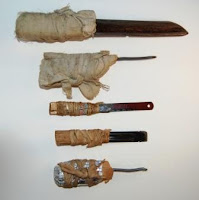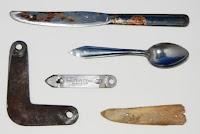In 2007, Louisiana State University (LSU) donated a collection of contraband weapons to the National Law Enforcement Museum. According to Barry Cowan, LSU Archivist, the weapons originally formed a display used by LSU’s Law Enforcement Training Program, which ran from 1953 through 2006. He says, “The LETP offered training for corrections officers, and I was told the display was designed to show students the types of weapons to look for when searching prisoners and their cells.” The term “shiv” is slang for any sharp, pointed object that is used as a knife, and can be created out of anything from a shard of glass to a hardened, sharpened toothbrush handle. Similarly, “shank” refers to a makeshift, knife-like weapon, and the two terms are often used interchangeably. The weapons seen here were all created from materials gleaned opportunistically; they show careful preparation and have been painstakingly sharpened, probably against a concrete floor or wall.
The term “shiv” is slang for any sharp, pointed object that is used as a knife, and can be created out of anything from a shard of glass to a hardened, sharpened toothbrush handle. Similarly, “shank” refers to a makeshift, knife-like weapon, and the two terms are often used interchangeably. The weapons seen here were all created from materials gleaned opportunistically; they show careful preparation and have been painstakingly sharpened, probably against a concrete floor or wall.
Contraband prison weapons, ca. 1960-1980. 2007.70. Collection of the NLEM, Washington, D.C. Mundane, easily available prison items are prime sources for contraband weapons. Dining utensils, machine- and wood-shop parts, and even meat bones left over from prisoner meals have been fashioned into lethal shivs and shanks. Toothpaste has been known to be used as a hardening agent when combined with paper, and thread pulled from prison uniforms or bedding is useful for “fishing” underneath doors or passing notes and other objects from cell to cell. The type of materials used, such as thread, cloth scraps, foil, etc., make contraband easy to hide, and corrections officers are carefully trained to control access to potentially dangerous materials and effectively search prisoner cells and common areas for hidden contraband and caches.
Mundane, easily available prison items are prime sources for contraband weapons. Dining utensils, machine- and wood-shop parts, and even meat bones left over from prisoner meals have been fashioned into lethal shivs and shanks. Toothpaste has been known to be used as a hardening agent when combined with paper, and thread pulled from prison uniforms or bedding is useful for “fishing” underneath doors or passing notes and other objects from cell to cell. The type of materials used, such as thread, cloth scraps, foil, etc., make contraband easy to hide, and corrections officers are carefully trained to control access to potentially dangerous materials and effectively search prisoner cells and common areas for hidden contraband and caches.
Correctional safety hygiene products, ca. 2008. Prop Collection of the NLEM. Shown is clear toothpaste, flexible handled toothbrush, “no-shank toothbrush,” disposable razor, unsharpened safety orange flexible pencil.
These items demonstrate the wide variety of objects in our collection. They document both the dangers that corrections officers face—there are close to 600 corrections officers on the National Law Enforcement Officers Memorial—and their response to those dangers. We will incorporate these objects into exhibits in the Museum and preserve them for future study.
Wednesday, January 20, 2010
Contraband Weapons—Shivs and Shanks at the NLEM
Labels:
artifacts,
contraband,
corrections officers,
Louisiana State Univ.,
prison,
prisoners,
shank,
shiv
Subscribe to:
Post Comments (Atom)

Almost anything in this world can turn into a weapon, toothbrush, pencils, pens, metal pieces, knife shave, inclusive a simple piece of hard plastic can be use to make a deadly weapon, this situation is more frequently in jails or mental care center, our politician must think a new way to protect our people from this deadly devices.
ReplyDelete